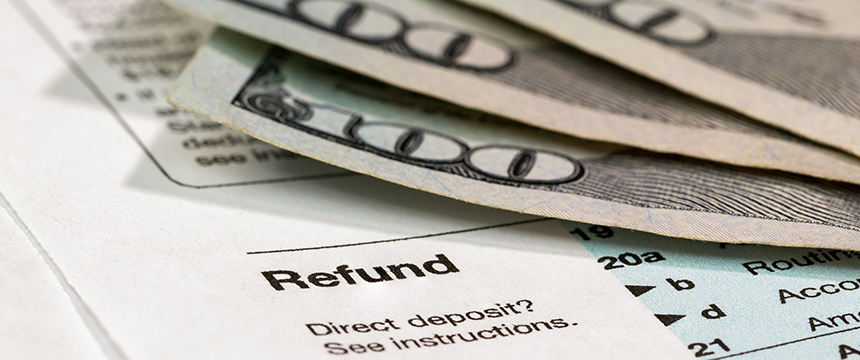
The Coronavirus Aid, Relief, and Economic Security Act (the “CARES Act”), which was signed by the President on March 27, 2020, includes several provisions affecting taxes. To review Foley’s summary of CARES Act, click here.
A summary of the key provisions is below.
SEC. 2201. 2020 Recovery Rebates for Individuals
Author: Julie Lee
The bill provides a $1,200 refundable tax credit for individuals ($2,400 for taxpayers filing jointly). In addition, taxpayers with children will receive $500 for each child. The rebate starts to phase out at adjusted gross income of $75,000 for singles, $112,500 for heads of household, and $150,000 for taxpayers filing joint returns at the rate of $50 per $1,000 of income in excess of the phase-out amount. It phases out entirely at $99,000 for single taxpayers with no children and $198,000 for taxpayers filing joint returns with no children.
A taxpayer generally does not need to do anything to claim the rebate. The IRS will calculate the amount of the rebate based on a taxpayer’s 2019 federal income tax return, or the 2018 tax return if the taxpayer has not filed the 2019 tax return and send the payment to the taxpayer. Taxpayers receiving rebates do not have to pay income tax on the rebates.
SEC. 2204. Allowance of Partial Above the Line Deduction for Charitable Contributions
Authors: Mike Woolever and Erin Lasenby
Section 2204 of the CARES Act (the “Act”) amends section 62 of the Internal Revenue Code of 1986 (the “Code”) by allowing taxpayers that do not itemize their deductions to take a limited above-the-line deduction for charitable contributions made during a taxable year beginning in 2020. Traditionally, the charitable contribution deduction is a below-the-line deduction available only to taxpayers who itemize. However, the Act allows taxpayers that do not itemize to deduct up to $300 in cash contributions made to qualifying charitable organizations, as described in section 170(b)(1)(A) of the Code, other than supporting organizations (as defined in section 509(a)(3) of the Code) or donor advised funds (as defined in Section 4966(d)(2) of the Code), and treat such contribution as an above-the-line deduction when computing adjusted gross income. Excess charitable contributions that have been carried over from prior tax years under Sections 170(b)(1)(G)(ii) or 170(d) are not includable as charitable contributions for purposes of this provision. The provision is effective for taxable years beginning after December 31, 2019.
SEC. 2205. Modification of Limitations on Charitable Contributions During 2020
Authors: Mike Woolever and Erin Lasenby
Section 2205 of the CARES Act temporarily modifies charitable contribution limitations for individuals, corporations, and food inventory contributions. Charitable contribution deductions are subject to various percentage limitations, and the CARES Act temporarily modifies such limitations. For individuals, the Act modifies the limitation from a maximum of 60% to 100% of adjusted gross income. If an individual’s contributions exceed the 100% limitation, the excess contributions may be carried over for the next five tax years. For corporations, the CARES Act modifies the limitation from 10% to 25% of taxable income. Similar to individuals, if a corporation’s contributions exceed the 25% limitation, the excess contributions may be carried over for the next five tax years. The CARES Act modifies the limitation for food inventory contributions under Section 170(e)(3)(C) from 15% to 25% for both C corporations and non-C corporations.
The modification of limitations applies to cash contributions paid in the 2020 calendar year and where the taxpayer has elected the application of this provision. However, this provision does not include contributions to supporting organizations (as defined in section 509(a)(3) of the Code) or donor advised funds (as defined in section 4966(d)(2) of the Code). Each partner or shareholder in a partnership or S corporation must make their carryover election separately. The modifications made by this provision apply to taxable years ending after December 31, 2019.
SEC. 2301. Employee Retention Credit for Employers Subject to Closure due to COVID-19
Authors: Tim Voigtman and Ben Genzer
Section 2301 of the CARES Act provides for a tax credit for employers subject to a closure related to COVID-19. The employment tax credit for eligible employers for each calendar quarter is equal to 50 percent of qualified wages with respect to each employee for such calendar quarter. Click here for a summary of additional guidance from the IRS and other sources.
Eligible Employer
An “eligible employer” is an employer which was carrying on a trade or business during calendar year 2020, and which meets either of two conditions with respect to any calendar quarter: (1) the operation of its trade or business is fully or partially suspended due to orders from an appropriate governmental authority limiting commerce, travel, or group meetings due to COVID-19 (a “Suspension”), or (2) such calendar quarter falls within the period beginning with the first 2020 calendar quarter for which gross receipts are less than 50 percent of gross receipts for the same calendar quarter in the prior year, and ending with the calendar quarter for which gross receipts are greater than 80 percent for the same calendar quarter in the prior year (a “Gross Receipts Decline”). A tax-exempt organization described in Code section 501(c) and exempt from tax under Code section 501(a) is an eligible employer if it is engaged in a trade or business and undergoes a Suspension (but not a Gross Receipts Decline). Various aggregation rules apply (including certain rules applicable to controlled groups) in determining whether there is a single employer.
Qualified Wages
The definition of “qualified wages” differs for eligible employers greater than 100 full-time employees and eligible employers with 100 or fewer full-time employees. The number of full-time employees is determined based on the average number of full-time employees (within the meaning of Code section 4980H) employed by such employer during 2019. The term “wages” includes wages as defined under Code section 3121(a) and compensation as defined under Code section 3231(e).
- Greater than 100 Employees: Qualified wages are wages paid to the extent the employee is not performing services due to the circumstances of a Suspension or Gross Receipts Decline.
- 100 or Fewer Employees: Qualified wages are any wages paid during a Suspension or Gross Receipts Decline, including circumstances in which the employee continued to provide services.
- Qualified wages taken into account for calculating the credit are limited to $10,000 per employee for all calendar quarters. In effect this means the maximum amount of credit attributable to any employee is $5,000.
- Qualified wages include the pre-tax portion of payments by the employer to provide and maintain a group health plan, generally allocated pro rata among employees and pro rata on the basis of periods of coverage (relative to periods to which such wages relate). The Secretary may provide additional guidance for allocating such health plan expenses.
- Qualified wages do not include any wages taken into account as qualified sick leave or qualified family leave under the Families First Coronavirus Response Act (“FFCRA”) and the employment provisions within the Families First Coronavirus Response Act. Additionally, qualified wages with respect to an employee may not exceed the amount such employee would have been paid for working an equivalent duration during the 30 days immediately preceding such period.
Credit Limit
The credit is limited to “applicable employment taxes” paid with respect to all employees for such calendar quarter, reduced by any credits under the FFCRA and Code section 3111(e) and (f) (relating to employment of qualified veterans and research expenditures of qualified small businesses). If the amount of the credit exceeds this limit for any calendar quarter, such excess shall be treated as an overpayment refundable under Code sections 6402(a) and 6413(b). Presumably, this will be handled in a manner consistent with similar tax credits under FFCRA, for which additional guidance is anticipated.
Applicable Employment Taxes
“Applicable employment taxes” means the employer portion of “Old-Age, Survivors, and Disability Insurance” (the 6.2 percent tax) under Code sections 3111(a) and 3221(a). However, the Department of Treasury has indicated in Notice 2020-57 that the tax credits under the FFCRA may be applied against remittance of wage withholding due from any payments of taxable compensation.
Exclusion
Employers are not eligible for this credit if the employer receive of any small business interruption loan received pursuant to section 1102 of the CARES Act.
Waiver
The Secretary will waive the penalty under Code section 6656 for failure to deposit if such failure was due to the reasonable anticipation of the credit allowed under this section.
Other Limits
There are additional limits where the taxpayer is taking advantage of certain other tax credits.
Effective Date
This credit is effective for wages paid after March 12, 2020 and before January 1, 2021.
SEC. 2302. Delay of Payment of Employer Payroll and SECA Tax Payments
Authors: Mike Abbott and Jordan Bergmann
The CARES Act permits most employers to delay payment of employer-portion Social Security taxes (6.2%). The delay applies to Social Security taxes due on wages paid between the date of enactment of the CARES Act and January 1, 2021. 50% of the delayed payroll taxes will be due by December 31, 2021, with the other 50% due by December 31, 2022.
The same deferral extends to (1) 50% of the Social Security taxes imposed under the Self-Employed Contributions Act (6.2%) and (2) employment tax imposed on employers under the Railroad Retirement Tax Act (6.2%).
Employers that receive loan forgiveness under Section 1106 (the Paycheck Protection Loan Program) or Section 1109 of the CARES Act are not eligible to defer the applicable taxes.
The CARES Act also exempts payroll processors and certified professional employers or organizations from the liability of the delayed taxes if directed by the employer or customer to delay payment until the applicable deadlines.
The Secretary of Treasury is required to issue regulations or other guidance to implement the delayed payroll and SECA tax payment provisions. Click here for a summary of the guidance issued April 10, 2020.
SEC. 2303. Modifications for Use of Net Operating Losses
Author: Mike Donahue
Introduction
A significant number of taxpayers are expected to suffer business losses (possibly substantial) in 2020 as a result of the coronavirus disease 2019 (COVID-19) outbreak. In an effort to provide financial assistance and liquidity to such taxpayers, the CARES Act amends the federal income tax rules applicable to the use of net operating losses (“NOLs”). Under the CARES Act, a taxpayer that incurs in 2020 (or has incurred during 2019 or 2018) an NOL is permitted to carryback such NOL to the prior five years to offset prior year income to claim a tax refund of previously paid federal income taxes.
Current NOL Tax Rules
Prior to 2018, if a taxpayer incurred an NOL in a tax year, the taxpayer was generally permitted to carry back and use such NOL against the taxpayer’s income for the prior two tax years. This permitted the taxpayer to receive a refund for taxes paid for the prior two years. Any NOLs not used against prior year income was generally permitted to be carried forward and used against future income for 20 years. The 2017 Tax Cuts and Jobs Act (the “2017 Act”) (P.L. 115-97), generally (i) eliminated the ability to carry back NOLs, and (ii) permitted the NOL arising in tax years beginning after December 31, 2017 to be carried forward indefinitely, limited to 80% of the taxpayer’s income. Certain exceptions to those 2017 Act provisions were provided for certain industries (e.g., farming, certain insurance companies, etc.). The NOL rules existing prior to the 2017 Act continued to apply to NOLs arising prior to the effective date of the 2017 Act.
Summary of 2020 NOL Amendments
5-Year Carryback of NOLs. The CARES Act amends Section 172 of the Internal Revenue Code to allow corporate NOLs arising in a taxable year beginning after December 31, 2017 and before January 1, 2021, to be carried back to each of the five taxable years preceding the taxable year of the loss. No election is required to carry back such NOLs.
- For calendar year taxpayers, NOLs arising in 2018, 2019 and 2020 are eligible to be carried back to the prior five taxable years, and continue to be carried forward indefinitely.
- The NOL is first carried back to the earliest tax year of the 5-year carryback period, and then to the next succeeding tax year in such carryback period. Note a “short tax period” (consisting of less than 12 months), of a taxpayer is treated as a full tax year for purposes of the 5-year carryback.
- The CARES Act does not change the current rule relating to capital losses.
- Taxpayers may elect to irrevocably waive the entire 5-year carryback period with respect to an NOL. Such election must be made by the due date (including extensions) for filing the taxpayer’s return (i) for the first tax year ending after the date the CARES Act is enacted, with respect to 2018 and 2019 NOLs, and (ii) for the tax year the loss is incurred, with respect to a 2020 NOL.
Observations
- Taxpayers that incur a 2020 NOL will not realize a tax benefit from the carryback provisions until its 2020 tax year is closed. However, such taxpayers should review with their tax advisors (i) their 2020 estimated tax payment situation to determine if such situation can be adjusted, and (ii) be prepared to file a refund claim promptly after its 2020 year closes (including pursuing a “quickie refund” on IRS Form 1139, if applicable). Taxpayers expecting a 2020 NOL should also analyze the possibility of accelerating deductions into 2020 to permit it to carry back such deductions as part of its 2020 NOL and increase any prior year tax refund.
- Taxpayers with 2018 and 2019 NOLs should promptly review its options to carry back any such NOLs and seek any applicable tax refunds, including amending a pre-2019 return, carrying back a 2019 NOL on the 2019 return if not yet filed, or filing for a tentative refund.
- Note that an NOL carried back by a C corporation to a pre-2018 tax year will typically be more valuable than a carry back to a post-2017 tax year since the maximum pre-2018 corporate federal income tax rate was 35% compared to 21% for post-2017.
- Post-2017 acquisitions of a target corporation by a corporate buyer raises interesting tax issues under the CARES Act. In such event, the target often (i) became a member of the buyer corporation consolidated tax group (resulting in a short target corporation tax year ending on the closing date) and (ii) reported an NOL on its short period tax return resulting from significant transaction tax deductions. Prior to the CARES Act, such NOL could not be carried back by the target corporation. After the CARES Act, the target seller may want to review its sale agreement to determine whether it is entitled to any possible pre-closing tax refunds that the target is entitled to.
- Interesting issues also arise if a corporate subsidiary member of a consolidated corporate tax group (i) was sold during 2018, 2019 or 2020 but (ii) had a pre-sale NOL that is eligible to be carried back to offset income reported on a prior consolidated return on which the loss member was included. In that event, the common parent of the selling consolidated group files the refund claim and typically is entitled to such tax refund, subject to any tax sharing agreement, the terms of the sale agreement, etc.
- An NOL carryback can affect the calculation of tax credits and deductions the taxpayer had previously claimed for the carryback year, including for example, (i) general business credit, (ii) the Internal Revenue Code Section 250 deduction (relating to global intangible low-taxed income (GILTI) for post-2017 tax periods), (iii) the Code Section 170(b)(2)(A) charitable contribution deduction (limited to 10% of taxable income), etc. Taxpayers should carefully review the impact of their tax situation and tax attributes resulting from carrying back an NOL.
Deferral of the 80% Taxable Income Limitation. The CARES Act retroactively suspends the 80% income limitation on use of NOL carryovers for taxable years beginning before January 1, 2021, and allows 100% of any such taxable income to be offset by the amount of such NOL carryforward. This 80% income limitation is reinstated (with slight modifications) for tax years beginning after December 31, 2021.
- NOLs arising in tax years beginning on or before December 31, 2017 taxpayer’s taxable income.
- NOLs arising in tax years beginning after December 31, 2017 and beginning before January 1, 2021 and carried to another tax year are permitted to fully offset the taxpayer’s pre-2021 taxable income.
- NOLs arising in tax years beginning after December 31, 2017 and beginning before January 1, 2021 and carried to a post-2020 tax year are permitted to offset only 80% of the taxpayer’s post-2020 taxable income.
- NOLs arising in tax years beginning after December 31, 2020 and carried forward to another tax year are permitted to offset only 80% of the taxpayer’s taxable income.
Observations
- Taxpayers whose use of prior NOLs were limited by the 80% income requirement should analyze its options under the CARES Act, including filing an amended tax return.
- When the 80% income threshold is applied for post-2020 tax years, it is calculated based on taxable income after giving effect to the use of pre-2018 NOLs (thus reducing the amount of income subject to the 80% threshold). Further, such income threshold is determined without giving effect to various specified deductions.
Application of Section 965 of the Internal Revenue Code. The 2017 Act enacted Section 965, which required certain U.S. shareholders of a foreign corporation to include in gross income, as of the end of 2017, their share of the foreign corporation’s earnings that were not previously subject to U.S. tax (with the option to defer a significant portion of the U.S. tax on such income to post-2017 tax years). Under the CARES Act, a taxpayer is not permitted to use an NOL carryback to offset and reduce its Section 965 income (thus is it permitted only to use such NOL carryback to reduce its non-Section 965 income for such carryback year).
- Such taxpayer can elect to exclude from its NOL carryback period any taxable year to which the taxpayer included a Section 965 income amount. This election is deemed timely made under Section 172(b)(3) of the Code (relating to waivers of NOL carrybacks) if made by the due date (including extensions) for filing the taxpayer’s tax return for the first tax year ending after the date of enactment of the CARES Act.
NOL Provisions for Fiscal Year 2018 Taxpayers. The CARES Act provides a technical correction to the 2017 Act that had prevented fiscal year taxpayers that incurred an NOL in a tax year ending in 2018 from being carried back. The CARES Act corrects the 2017 Act language to provide fiscal year taxpayers who had NOLs arising in a tax year that began prior to December 31, 2017 and ended after December 31, 2017 with the ability to carry back those NOLs. Further, with respect to filing a carryback claim for a tax year that began prior to December 31, 2017 and ended after December 31, 2017, the CARES Act provides a carryback claim is deemed timely filed if it is filed no later than 120 days after the enactment of the CARES Act.
Special Rules for Real Estate Investments Trusts (REITs) and Life Insurance Companies. A REIT is not permitted to carry back any NOL (and an NOL may not be carried back to any year in which the taxpayer was a REIT). Also, life insurance companies are required to treat NOL carrybacks to pre-2018 tax years as operating loss deduction carrybacks (subject to from Section 810 of the Internal Revenue Code as in effect in those years).
SEC. 2304. Modification of Limitation on Losses for Taxpayers other than Corporations
Authors: David Weisblat and Ashley May
As a result of the Tax Cuts and Jobs Act, a non-corporate taxpayer’s ability to deduct “excess business losses” was limited during tax years beginning after December 31, 2017, and before January 1, 2026. Excess business losses are the amount by which the total deductions attributable to all of a taxpayer’s trades or businesses exceed such taxpayer’s total gross income and gains attributable to those trades or businesses plus $250,000 (or $500,000 in the case of a joint return).
The CARES Act amends this limitation so that it applies only to taxable years beginning after December 31, 2020. As a result, excess business losses that would otherwise be disallowed for taxable years 2018 through 2020 will be permitted (i.e., receive the same treatment as if the Tax Cuts and Jobs Act had not been enacted).
The CARES Act also provides technical amendments related to excess business losses (as written in the Tax Cuts and Jobs Act), including the following corrections and clarifications:
- It clarifies how excess business losses are to be carried forward to subsequent taxable years; and
- That excess business losses are to be determined without regard to:
- Any deductions, gross income or gains attributable to any trade or business of performing services as an employee (including any deduction allowable under Sections 172 or 199A of the Code).
- Deductions for losses and certain gains from the sales or exchanges of capital assets.
The above technical amendments are effective as if they were included in the provisions of the Tax Cuts and Jobs Act to which they relate.
SEC. 2305. Modification of Credit for Prior Year Minimum Tax Liability of Corporations
Authors: Mike Woolever and Erin Lasenby
The CARES Act amends section 53 of the Internal Revenue Code of 1986 (the “Code”) to accelerate a corporation’s ability to recover AMT refundable credits under section 53(e) that otherwise could have been claimed in 2020 and 2021, to 2018 and 2019, with an option to elect recovery of the full credit amount for 2018. As a result, corporations may obtain additional cash flow that can be used to address the impacts of COVID-19.
The Tax Cuts and Jobs Act of 2017 repealed the corporate alternative minimum tax (“AMT”), but allowed a credit of AMT paid in prior tax years to be used against a corporation’s normal tax liability in taxable years 2018, 2019, 2020, and 2021 and to treat 50% of the credit as refundable in taxable years 2018-2020 and 100% for taxable years beginning in 2021. The CARES Act provides that 100% of an AMT credit will be treated as refundable in the case of a taxable year beginning in 2019.
Further, the CARES Act provides a special election to take the entire refundable credit amount in 2018 and to file a tentative refund claim no later than December 31, 2020 using Form 1139. Such credit with such refund claim is to be verified and processed in a manner similar to tentative refund claims filed under section 6411 of the Code. The CARES Act requires the Secretary of the Treasury to review the application, determine the amount of the overpayment, and apply, credit, or refund such overpayment, within 90 days of filing in the same manner as section 6411(b) of the Code. If a corporation filed or was required to file a consolidated return, either for the taxable year in which the credit arose or for the preceding taxable year affected by such loss or credit, the provisions of section 6411(c) of the Code shall apply to adjustments to the same extent and manner as the Secretary of Treasury may provide.
On April 13, 2020, the IRS announced that taxpayers may temporarily file Form 1139 by fax beginning April 17, 2020 and until further notice. If, after March 27, 2020, a taxpayer has already mailed a hard copy of Form 1139, the taxpayer may re-submit the same claim via fax. The IRS has made clear that it does not intend to make the fax option a permanent method of filing refund claims. Additionally, the IRS will allow Form 1139 to be used to claim refunds for section 965(a) inclusion years, thus taxpayers may disregard instructions that prohibit use of the form to apply for refunds for section 965 years.
The amendments made by this section apply to taxable years beginning after December 31, 2017.
SEC. 2306 Modifications of Limitation on Business Interest
Authors: James Howard and Tori Roessler
Starting in 2018, Section 163(j) of the Code imposed a limit on trade or business interest deductions. The amount of deductible business interest expense in a taxable year cannot exceed the sum of:
- the taxpayer’s business interest income for the year;
- 30% of the taxpayer’s adjusted taxable income for the year; and
- the taxpayer’s floor plan financing interest expense for the year.
Disallowed interest is considered paid in the following tax year and may be carried forward indefinitely. There are certain exceptions to these limits for: (i) certain small businesses (those with average gross receipts over the three prior tax years no greater than $25 million), (ii) regulated public utilities, and (iii) electing real property or farm trades or businesses.
The CARES Act increases the adjusted taxable income limit from 30% to 50%. Generally, the increase is allowed for taxable years beginning in 2019 and 2020. Special rules apply to partnerships, and the increase is only allowed for the partnership’s taxable year beginning in 2020. Because of this special rule for partnerships, the CARES Act contains special rules for excess business interest allocated to partners for the taxable year beginning in 2019. Taxpayers may elect out of this increase for either taxable year; however, such election is irrevocable absent the Secretary’s consent.
This increase in allowable deductions of interest expense will reduce cash taxes for taxpayers subject to the 163(j) limit and allow these businesses increased liquidity, so that they may continue operations and keep employees on the payroll.
Subsequent to the passage of the CARES Act, the IRS issued guidance in the form of Revenue Procedure 2020-22, which may be found here. Rev. Proc. 2020-22 provides instruction on how taxpayers can make the elections provided under the CARES Act regarding the Section 163(j) limitation. Specifically, Rev. Proc. 2020-22 provides the following: (i) an automatic extension for certain taxpayers to file an election under Section 163(j)(7)(B) or (C), (ii) an opportunity for certain taxpayers to withdraw a prior election under Section 163(j)(7)(B) or (C), and (iii) the time and manner by which certain taxpayers can make elections under the new Section 163(j)(10), which include the elections (x) not to apply the 50% ATI limitation, (y) to use the taxpayer’s ATI for the last taxable year beginning in 2019 to calculate the 2020 limitation, and (z) for a partner to elect out of the 50% excess business interest rule.
SEC. 2307. Technical Correction of Bonus Depreciation for Qualified Improvement Property
Authors: Steve Good and Jordan Bergmann
The CARES Act includes a fix for, and clarification to, the bonus depreciation rules under Section 168(k) of the Code.
Tax Cut and Jobs Act of 2017 (“TCJA”) contained a provision allowing taxpayers to claim bonus depreciation deductions (up to 100%) for certain types of “qualified property,” which included property with a depreciable life of 20 years or less. The TCJA also separately defined the concept of “qualified improvement property” (“QIP”), which was defined as “any improvement to an interior portion of a building which is nonresidential real property if such improvement is placed in service after the date such building was first placed in service.” While the TCJA defined qualified improvement property, it failed to assign it a 15-year depreciable life, thereby preventing it from being treated as “qualified property” that would be eligible for bonus depreciation deductions. The omission was widely recognized as a drafting mistake requiring legislative correction to be remedied.
The CARES Act corrects the drafting error by assigning a 15-year depreciable life to QIP, thereby allowing it to be characterized as “qualified property” eligible for bonus depreciation. The CARES Act also revised the definition of “qualified improvement property” to limit that concept to “improvements made by the taxpayer,” thereby eliminating the possibility of the taxpayer getting bonus depreciation for “used” QIP that was purchased by the taxpayer, an issue that was an open question under the statute as originally drafted. These corrections are effective retroactively as if they had been included in the TCJA.
The provision should not only increase a company’s access to cash flow by allowing it to amend prior year tax return, but also incentivize taxpayers to continue to invest in improvements as the country recovers from the COVID-19 emergency.
SEC. 2308 Temporary Exception from Excise Tax for Alcohol Used to Produce Hand Sanitizer
Authors: James Howard and Tori Roessler
The CARES Act eliminates excise tax on distilled spirits removed after December 31, 2019 and before January 1, 2021, used in or contained in hand sanitizer produced and distributed in a manner consistent with any guidance issued by the FDA related to the outbreak of COVID-19. While denatured alcohol is already exempt from tax, distillers were concerned that using undenatured alcohol—or, alcohol meant for human consumption—to produce hand sanitizer would subject them to millions in taxes. Before the CARES Act, the federal excise tax on these distilled spirits was $2.70 per gallon for the first 100,000 gallons produced in a single calendar year. For every additional gallon, the tax was $13.34 per gallon until more than 22 million gallons are made and, afterwards, $13.50 per gallon.
Foley has created a multi-disciplinary and multi-jurisdictional team, which has prepared a wealth of topical client resources and is prepared to help our clients meet the legal and business challenges that the coronavirus outbreak is creating for stakeholders across a range of industries. Click here for Foley’s Coronavirus Resource Center to stay apprised of relevant developments, insights and resources to support your business during this challenging time. To receive this content directly in your inbox, click here and submit the form.



